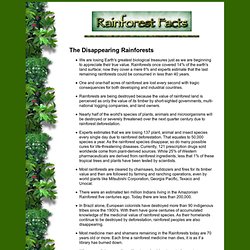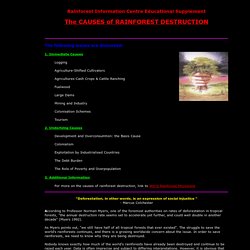

Help with Rainforest School Reports. Current State of Tropical Rainforests. Rainforests have always been subject to destructive natural forces -storms, landslides, floods, mud flows, volcanic eruptions, high winds, fire (mainly from lightning), drought, and climate change.

These factors have recently been overwhelmed by anthropogenic (human) forces, however, as rainforests are being cut down everywhere at a very high rate. Approximately 50% of land which could support tropical rainforests now lacks it because of human activities. Deforestation is not a recent human activity only, as rainforests have been inhabited by humans for thousands of year. Charcoal deposits, indicative of human activity, have been found in the sediments of many tropical rainforests which we regard as virgin forests.
Many patches of rainforest also show peculiar distributions of plant species some attribute to human “enrichment” of the forest with useful species. We do not know the exact relationship between deforestation rates and loss of biodiversity. Rainforest Facts. The Disappearing Rainforests We are losing Earth's greatest biological treasures just as we are beginning to appreciate their true value.

Rainforests once covered 14% of the earth's land surface; now they cover a mere 6% and experts estimate that the last remaining rainforests could be consumed in less than 40 years. One and one-half acres of rainforest are lost every second with tragic consequences for both developing and industrial countries. Rainforests are being destroyed because the value of rainforest land is perceived as only the value of its timber by short-sighted governments, multi-national logging companies, and land owners. Nearly half of the world's species of plants, animals and microorganisms will be destroyed or severely threatened over the next quarter century due to rainforest deforestation.Experts estimates that we are losing 137 plant, animal and insect species every single day due to rainforest deforestation.
Tropical Rainforest. Where are tropical rainforests found?

Tropical rainforests are located around the equator where temperatures stay near 80 degrees year round. Rainforests receive 160 to 400 inches (400-1000 cm) of rain each year. The largest rainforests are in Brazil (South America), Zaire (Africa) and Indonesia (South East Asia). Rain Forest Report Card. Deforestation of Tropical Rain Forests Throughout the tropics, rain forests are being cut down.

By different methods and for different reasons, people in tropical regions of the world are cutting down, burning, or otherwise damaging the forests. The CAUSES of RAINFOREST DESTRUCTION. Return to Education Supplement ContentsRainforest Information Centre Educational Supplement The CAUSES of RAINFOREST DESTRUCTION The following issues are discussed: 1.

Immediate Causes Logging Agriculture-Shifted Cultivators Agricultures-Cash Crops & Cattle Ranching Fuelwood Large Dams Mining and Industry Colonisation Schemes Tourism 2. Underlying Causes Development and Overconsumtion: the Basis Cause Colonialism Exploitation by Industrialised Countries The Debt Burden The Role of Poverty and Overpopulation 3. For more on the causes of rainforest destruction, link to World Rainforest Movement "Deforestation, in other words, is an expression of social injustice " - Marcus Colchester According to Professor Norman Myers, one of the foremost authorities on rates of deforestation in tropical forests, "the annual destruction rate seems set to accelerate yet further, and could well double in another decade" (Myers 1992). We can stop using tropical timber and urge others to do the same.
Current State of tropical rainforests. Rainforest Importance. Environmental Facts. Rainforests are forests which grow in areas of high rainfall.

Tropical rainforests are found between the Tropic of Cancer and the Tropic of Capricorn and receive between 68”-78” (175-200 cm) of rainfall a year. Those nearest to the equator, where the climate is very hot and wet all through the year, are evergreen because the trees can grow all the time and so are always in leaf. They are found in South and Central America, Central Africa, Indonesia, Malaysia and the north eastern tip of Australia. There are other, temperate rainforests in areas such as the northwest Pacific coast of America, in the cooler parts of Central America and India.. These are much cooler, but experience very high rainfall during the wet season. Cloud forests are yet another type of rainforest, so-called because they can be found high up mountains, where they are nearly always in cloud. 1. There are many reasons why rainforests are important which can be put under the following headings: Back to the top. Medicines.